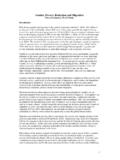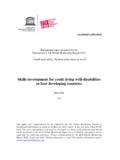Transcription of HS–8: The World Economy, 1–2001 AD
1 241 The World Economy, 1-2001 ADHS 8: The World Economy, 1 2001 ADTables HS 8 show levels of population, GDP and per capita GDP in 20 countries, 7 regions andthe World for eight benchmark years in the past two millennia. There are also 5 analytical tablesshowing rates of growth and shares of World population and GDP. HS 7 explained the derivation ofestimates for 1950 2001. Earlier than this, it is useful to distinguish between estimates for 1820 1950and those for the centuries before 1820 where the documentation is weaker and the element ofconjecture Movement 1820 1950 For West European countries and Western Offshoots, population estimates for this period arebased mainly on censuses dating back to the eighteenth century for Scandinavia and Spain and theearly nineteenth for most other countries.
2 The sources are described in HS 1 and HS 2. For WesternEurope, annual estimates, adjusted to a midyear basis are shown for all countries back to 1820. ForWestern Offshoots, they are shown separately for the indigenous population and those of European/African origin at decade intervals for 1820 1870, with annual estimates for the total population Eastern Europe, annual estimates are shown from 1920. Before the first World war, these countrieswere divided between the Austro Hungarian, Ottoman, Russian and German Empires. Derivation ofestimates in the territory corresponding to present boundaries is possible, but they are too rough towarrant presentation on an annual basis.
3 Estimates for the territory of the former USSR are also toorough to warrant annual presentation before 1920. Population sources are described in HS Latin America annual estimates are shown back to 1900 for 23 countries. The 1820 and1870 estimates in Maddison (2001) for the smaller countries are revised and augmented from theCambridge History of Latin America, Engerman and Higman (1997) and other sources cited in HS Asia annual estimates are shown from 1913 for the 16 core countries, and for benchmarkyears 1820, 1850 1870 1890 and 1900. For China, India, Indonesia and Japan annual estimates areshown back to 1870.
4 For other countries there are estimates for benchmark years 1820, 1870, 1900and 1913. In most cases the sources in HS 5 are the same as in Maddison (2001).For Africa, the statistical basis is weaker than elsewhere. I show no annual estimates before1950, but give detail for the sample countries for 1820, 1870 and 1913 in Table 6 10 of HS Change 1 1820 ADFor the centuries before 1820 the most comprehensive evidence is for population and it is ofgreater proportionate importance for analysis as per capita income growth was much slower then andeconomic growth was largely World Economy: Historical StatisticsDemographic changes, increases in life expectancy, changes in average age which affectlabour force participation, changes in the structure of the labour force , are important in providingclues to per capita income development.
5 A striking example is the urbanisation ratio. Thanks to thework of de Vries for Europe and of Rozman for Asia, one can, for some countries, measure the proportionof population living in towns with more than 10 000 inhabitants. In the year 1000, this ratio wasvirtually zero in Europe (there were only 4 towns with more than 10 000 inhabitants) and in China itwas 3 per cent. By 1800 the West European urban ratio was per cent, the Chinese per countries are able to expand their urban ratios, it indicates a growing surplus beyond subsistencein agriculture, and suggests that the non agricultural component of economic activity is changing differentials in urban ratios were used to buttress other evidence on per capita progressin China and Europe in Maddison (1998).
6 The Chinese bureaucracy kept population registers whichgo back more than 2 000 years. These records were designed to assess taxable capacity, and includeinformation on cultivated area and crop production, which was used by Perkins (1969) to assess longrun movements in Chinese output per capita. Bagnall and Frier (1994) made brilliant use of fragmentsof ancient censuses to estimate occupational structure, household size, marriage patterns, fertility andlife expectation in Roman Egypt of the third work on historical demography started in the seventeenth century with John Graunt (seePrologue). Modernised techniques and similar types of evidence have been used to make retrospectiveestimates of population for other European countries for periods before census material was of this character have been carried out by a) the Office of Population Research in PrincetonUniversity (established in 1936); b) INED (Institut National des tudes D mographiques) founded inthe 1950s to exploit family reconstitution techniques developed by Louis Henry.
7 C) the CambridgeGroup for the History of Population and Family Structure (established in the 1970s) has carried out amassive research project to reconstitute English population size and structure on an annual basis backto 1541 (Wrigley et al., 1997). This kind of analysis has been sharpened by the application of massivecomputing on Japanese population history has blossomed under the leadership of Akira Hayamiand Osamu Saito. Ester Boserup s (1965) analysis of the interaction between demographic pressure,agricultural technology and intensity of labour input in Asia has helped discredit simplistic Malthusianinterpretations.
8 There has been a flood of publications on Latin American demography and the shipmentof slaves from Africa. As a result of these efforts we are better placed to measure long term changes inworld population. The most detailed and best documented are those in McEvedy and Jones (1978).This was the source of my estimates for Africa (see also the masterly analysis of African developmentin McEvedy, 1995).Appendix B of Maddison 2001 provided source notes and estimates for 20 countries and 7 regionsfor benchmark years between the first century and 1700. In this study more country detail is shown forWestern Europe, Western Offshoots, Latin America back to 1500 and for Africa back to the first are some changes in the regional totals for Africa (see Table 6 1), but none for other Growth 1820 1950 Before the second worldwar, only 10 countries had official estimates of national income,assembled without international guidelines to provide comparability.
9 None of these are suitable forour purpose, but there are retrospective official estimates of fairly recent vintage which I used forAustria from 1830, Norway from 1865, Netherlands from 1913, Canada from 1926 and the UnitedStates from were non official estimates in pre war years. Colin Clark (1940) made a comprehensivesurvey, but all those he cited have now been superseded. In the past 60 years, work on retrospectivenational accounts has been undertaken by a large number of scholars who have generally linked their243 The World Economy, 1-2001 ADseries to official post war estimates. The initial thrust for these exercises in quantitative economichistory was given by Simon Kuznets.
10 His very long career included creation of official US accounts in1934 and 5 monographs of historical accounts for the United States in 1941 61. These set highstandards of scholarship with meticulous and transparent description of sources and methods. Thesecharacteristics have permitted succeeding generations of scholars to stand on his shoulders. Hispersuasive power and influence stemmed from professional integrity and depth of scholarship. Hewas free from partisanship, open to new ideas and willing to comment sympathetically in detail on thework of others. His influence was reinforced by his style of analysis use of ideas that could be clearlyexpressed in literary form, and implemented with relatively simple statistical techniques.







